|
FAQs about Caryophyllid Coral Disease, Pests,
Predation 8
Related Articles:
Coral Pests and
Disease; pests, predators, diseases and conditions by Sara
Mavinkurve, Caryophyllid
Corals, Elegance Coral,
FAQs on Euphylliid Disease:
Caryophyllid Disease 1, Caryophyllid Disease 2, Caryophyllid Disease 3, Caryophyllid Disease 4, Caryophyllid Disease 5, Caryophyllid Disease 6, Caryophyllid Disease 7,
Euphylliid Health 9, Euphylliid Health 10, & Elegance Coral Disease/Pests,
FAQs on Euphylliid Disease by Category:
Diagnosing,
Environmental (Pollution/Poisoning, Lighting...),
Nutritional, Social (Allelopathy),
Trauma,
Pathogenic (Infectious, Parasitic, Viral)
Predatory/Pest, Treatments
FAQs on Stony Coral Disease by Category: Diagnosing,
Environmental (Pollution/Poisoning, Lighting...),
Nutritional, Social (Allelopathy),
Trauma,
Pathogenic (Infectious, Parasitic, Viral)
Predatory/Pest,
Treatments
Caryophylliids 1, Caryophylliids 2, Caryophylliids 3, Caryophylliids 4, Caryophyllid ID, Caryophyllid Compatibility, Caryophyllid Systems, Caryophyllid Selection, Caryophyllid Behavior, Caryophyllid Feeding, Caryophyllid Propagation/Reproduction,
Stony/True Coral, Coral System Set-Up, Coral System Lighting, Stony Coral Identification, Stony Coral Selection, Coral Placement, Foods/Feeding/Nutrition, Disease/Health, Propagation, Growing Reef Corals, Stony Coral Behavior,
|
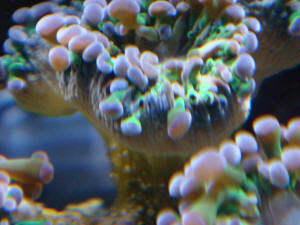
|
|
Re: Devastating Tank Loss: Overstocked tank crash.
Nothing really to refer. 7/13/2009
<Hi Melissa, sorry for the delay in writing back, I've
been in Montreal for the last week or so.>
I am writing back to give an update because we have had a small
miracle.
<Oh?!>
Our TR clown has pulled through. His recovery from being on his
side and gasping the entire day after the equipment disaster, to
swimming around this morning has been a wonderful surprise.
<Excellent News.>
I haven't yet seen a fish come back from this. When he was on
his side we thought him gone and were going to scoop him out but
he swam away and kept at it, something about him gave me hope
even though I really know better. He was very healthy and fat
before the rescue operation, I suppose this aided in his ultimate
survival.
<Indeed.>
I did a huge water change 40%; the ammonia & ph are 0,
nitrates cut down by half at 0 and nitrites 0. As of this
morning, all corals (2 torch, a frogspawn and mushroom are open
and looking good so far). Also I grabbed a bit of water last time
I was in the LFS and tested it when I got home, I was amazed at
the PH levels being off my charts; is this normal? Everything
else tested at 0's.
<Depends on how they make up their water.>
As an answer to your question the extra "emergency"
fish were in our tank for close to three weeks, not even regular
water changes kept the levels down. One other thing that you
mentioned regarding how it would have been better to take the
fish back to store, but we really don't have a store that
will take them back. When I took out the chromis, I had no idea
where to take them and stopped at a Petco where they surprised me
by taking them as a donation. But years ago I had some fish that
needed a home when my tank cracked and the local stores there
wouldn't take them.
<I can understand their position as well, as they do not want
to potentially introduce disease to their tanks.>
I finally found one even though they still gave me a very hard
time. Had I known they would not come through and get their
animals back I would have set something else up. Live and learn,
at my animals expense!
<Yes.>
So I thank you for your time and again wanted to celebrate the
survival of a very tough TR clown. Now I have the levels back to
safe levels, got the spg up to 1.024 (the spg is hard to keep up
in this system, funny as years ago we had 100 gal+ tanks and we
had to add fresh water to keep this down) and eventually get a
new cleaner shrimp or a pair and get back to enjoying our tank
again.
<Very good.>
I also attached some photos of my torch coral as there is a large
"something" on the side. It is hard like the base, but
it separates from the base ever so slightly. I tried to show the
side so this can be viewed, but wasn't very successful. I
included the pics anyway. I would appreciate your comments/info.
I tried to search but the general terms I used didn't locate
anything similar and I didn't have any more descriptive
terms.
<Hmm... will refer to others more knowledgeable on
corals.>
Thank you
M
<MikeV>
|
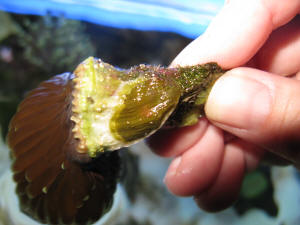 .jpg) |
Re: Devastating Tank Loss: Additional
Crew follow-up: From MikeV 07/14/09
Crew,
Can someone look at the two pictures of the Torch Coral I
haven't seen anything like that before.
Thanks
MikeV
<Am looking at right now Mike. My comments below. BobF>
I am writing back to give an update because we have had a small
miracle.
Our TR clown has pulled through. His recovery from being on his
side and gasping the entire day after the equipment disaster, to
swimming around this morning has been a wonderful surprise. I
haven't yet seen a fish come back from this. When he was on his
side we thought him gone and were going to scoop him out but he
swam away and kept at it, something about him gave me hope even
though I really know better. He was very healthy and fat before the
rescue operation, I suppose this aided in his ultimate
survival.
I did a huge water change 40%; the ammonia & ph are 0, nitrates
cut down by half at 0 and nitrites 0. As of this morning, all
corals (2 torch, a frogspawn and mushroom are open and looking good
so far). Also I grabbed a bit of water last time I was in the LFS
and tested it when I got home, I was amazed at the PH levels being
off my charts; is this normal? Everything else tested at
0's.
<Mmm, normal? Yes... marine systems that are "large,
stable" enough, can/do recenter themselves... bio-, chem-, and
physically>
As an answer to your question the extra "emergency" fish
were in our tank for close to three weeks, not even regular water
changes kept the levels down. One other thing that you mentioned
regarding how it would have been better to take the fish back to
store, but we really don't have a store that will take them
back. When I took out the chromis, I had no idea where to take them
and stopped at a Petco where they surprised me by taking them as a
donation. But years ago I had some fish that needed a home when my
tank cracked and the local stores there wouldn't take them. I
finally found one even though they still gave me a very hard time.
Had I known they would not come through and get their animals back
I would have set something else up.
Live and learn, at my animals expense!
So I thank you for your time and again wanted to celebrate the
survival of a very tough TR clown. Now I have the levels back to
safe levels, got the spg up to 1.024 (the spg is hard to keep up in
this system, funny as years ago we had 100 gal+ tanks and we had to
add fresh water to keep this down) and eventually get a new cleaner
shrimp or a pair and get back to enjoying our tank again.
I also attached some photos of my torch coral as there is a large
"something" on the side.
<The green, uniform area?>
It is hard like the base, but it separates from the base ever so
slightly. I tried to show the side so this can be viewed, but
wasn't very successful. I included the pics anyway. I would
appreciate your comments/info. I tried to search but the general
terms I used didn't locate anything similar and I didn't
have any more descriptive terms.
Thank you
M
<I think this is likely an algal colony/growth... from
opportunistic chances, ongoing changes, trauma in your system... I
would not "treat it" in any way... Will likely cycle out
in time on its own. Bob Fenner> |
Removing Bristle Worm From Bubble Coral 7/8/09
Hi,
<Hello from Key Largo!>
I have a bubble coral that I purchased 10 months ago. It was injured
and only had a few bubbles on it when I bought it (they said it had a
50/50 chance).
<Impressive you've managed to keep it alive this long!>
Anyway I read up about them and started to target feed it.
<This will benefit this coral. I would also recommend you soaking
your food in Selcon as well.>
It started to look better. About two months ago it began to grow a new
skeleton.
<Very good.>
So far so good. Then last night I saw 2 bristle worms poke out from the
skeleton underneath the bubbles. First I was wondering if they are
eating the bubble coral?
<Likely not. Generally bristle worms eating dying/decaying matter,
not living tissues.>
Second, How do I get them out of there without causing damage to the
bubble coral.
<I would likely not remove, you can observe the coral, but even if
you see tissue loss, that does not necessarily indicate that the
bristle worms are doing the damage, more likely they are doing a
beneficial service of removing the damaged tissue.>
Your help would be greatly appreciated. I have a 180 gallon tank with 1
coral banded shrimp, 1 fire shrimp,
<I would add another so they might pair up and the spawn can feed
your tank.>
1 blue hippo,1 kole tang,1 clown, 2 mandarins,1 Flameback angel,1
Foxface, and 1 yellow tang.
<Watch all those tangs!>
Also have many snails and hermits, and 2 feather dusters.
Thanks,
<Welcome!
Mich>
Jeanine
|
Euphyllia Eating Flatworm? Polyclad --
4/30/09
Hi!
<Hi there, Cath!>
I've lost several of my Euphyllia corals in the last couple
of months.
<Uh-oh>
This morning, I've found what I think is a kind of flatworm
on many of my frog, torch and ancora pieces. With a close look
and more attention, I saw that all my Euphyllia are literally
infested by this 'little' (some are up to
½') beast.
<Yikes!>
There are also a lot of yellow eggs around them. Here is, in a
joined piece, a picture of the beast. The shot was not taken by
me, but by a fellow reefer of my area who has the same problem.
What exactly is this flatworm?
<Looks like a Polyclad of some sort to me (see link below for
more info).>
Is there a way to get rid of them?
<Manual/diligent removal of all visible worms/eggs. In
addition, check any and all other corals (and rockwork if
possible) for further evidence and remove any you come across.
I'd also put the corals, one at a time, in small tub or
container with tank water, and using something like a turkey
baster, blast any areas of dead skeleton/rockwork with water to
hopefully dislodge any unseen juveniles.>
I've made a lot of searches and haven't found anything
about it.
<That's understandable. I looked everywhere and only found
a couple of unconfirmed hobbyist reports related to Euphyllids
and suspected Polyclad predation. Furthermore, I was unable to
find any documentation, anywhere, confirming actual predation of
any coral species by these worms at all. That's not to say
that it's not possible however. Apparently, there's a lot
of information still needing to be discovered/revealed regarding
these large worms. The general consensus is that they're all
predatory - consuming various colonial or sessile organisms such
as Tunicates, Bryozoans, bivalves, barnacles, etc, as well as
other small invertebrates such as amphipods, small snails,
Polychaete worms, and even other flatworms. Also, some evidently
feed on algae, especially diatoms, but only as juveniles. The
problem with this situation is that unless you've actually
seen the worms eating live coral tissue, you have to consider
that their presence may be secondary/incidental. Perhaps the
corals are dying due to one or several other reasons -- for
instance environmental issues (water chemistry, chemical
warfare/allelopathy, etc), or due to fish/crabs, etc picking at
them. The culprit could even be another type of flatworm (perhaps
Acoels?) or something else entirely. The Polyclad flatworms could
be there to prey on the real predator(s), or other
incidental/harmless amphipods, etc, that have congregated to
feast on the sudden bloom of algae and/or dying coral tissue.
Admittedly, an infestation level of anything near a damaged coral
doesn't look good, but I'd rule out other possibilities
just to be sure. I have to admit, if I were in your shoes,
I'd likely err on the side of caution and remove as many
Polyclads as I could. Had there been just one or two, I'd
have left it/them, but in the case of many -- bye bye!
I've got some links for you to read through. Here's a
similar situation: FAQ titled 'Euphyllia Health issues /
hitch hiker ID... likely allelopathy, env. 6/9/08', at this
link: http://www.wetwebmedia.com/carydisf7.htm
Allelopathy issues: http://wetwebmedia.com/cnidcomppt3.htm
Flatworms: http://www.wetwebmedia.com/flatworms.htm >
Thank you!
Cath
<You're very welcome! Take care, LynnZ>
|
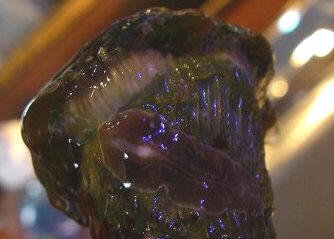 |
Frogspawn Parasite, or just feeding, barnacle
04/02/09
Picked up a Branching Frogspawn from our LFS today, There are four
heads, and directly in between two of the heads is a round piece of
skeleton that sticks out about 1/4 inch farther then the other parts of
the skeleton.
There is a hole on this piece, and periodically, little
"feathers" come out, spin a little bit, then retract.
<This sounds like a barnacle. A picture would be helpful to confirm.
Some can be trouble depending on their location on the coral.>
It kind of looks like a feather duster, but has only a few, (less than
ten) very thin feathers, and they are arranged in a sort of crescent
shape, not even a half circle. They really don't seem to be
affected by light that
much. Is this a parasite, or is it a part of the coral and the way it
eats or something. Thanks for your continued help.
<I don't know if I'd call it a "parasite" per se,
but if it is a barnacle (and if it grows too big in the wrong place) it
can cause some annoyance to the coral. I wouldn't try to remove it
at this point though. Please do try to send a pic.
Cheers,
Sara M.>
Re: Frogspawn Parasite, or just feeding
04/02/09
I have confirmed through pictures online that it is a barnacle, so i
should leave it?
<I would remove it IF it is easy to remove. Try breaking it off with
a pair of needle-nose pliers. If it comes/breaks off easy, good... if
not, I wouldn't go to any extreme measures to remove it.>
If a picture is necessary to tell me if i need to remove it, or to
leave it, i can take a pic tomorrow morning when the lights come on. Do
barnacles pose any threat to the other members of the tank?
<No. I'm not even entirely sure they cause frogspawn any
trouble.
However, I have heard stories (and seen pictures) of barnacles growing
in/on the actual polyps, close to the mouths. Some people swear that a
barnacle growing in such a place has killed their polyps... but I
don't know. I think the barnacles (filter feeders) just grow where
they grow, and sometimes it's inconvenient for a coral.>
we have cleaner shrimp, clownfish, mandarin, hermits, all types of
snails, open brain, lobos, torch, spaghetti leather, mushrooms, Acros,
and pulsating xenias.
<Best,
Sara M.>
Torch coral... hlth? Beh.? 03/01/09 Hello good day
to you. Have a small question today. I have a few Hammer and Torch
corals in my tank. All are doing great, with excellent polyp extension.
I provide them with moderate flow and moderate lighting. So far they
look very happy and reward me with beautiful and healthy looking
extension of their tentacles. However, I did notice something. One of
my Torch and one of my Hammer Corals seem to have lost its stickiness
on its tentacles. The others are doing fine, with sticky tentacles that
enable them to catch mysis and the occasional table shrimp. I just
wanted to know if the coral is declining? I really hope not because it
is one my favourite corals. I feed my tank 3 small portions a day,
rotating between mysis, pellets and my own blend of seafood. I have a
healthy amount of fish that produce waste (I heard some corals like
fish fecal matter?), and 20% water changes about once a week. Please
advise on my situation..I do hope that they are still getting enough
food via photosynthesis and the dissolved organics along with some very
fine food that they might get through absorbtion. The only thing that
they cannot seem to get hold of is bigger pieces of food due to their
non-sticky tentacles. <Kai, I'm not even sure this seeming lack
of "stickiness" is even a problem/concern. If the corals are
not receding and are extending as normal, I'd assume they're
ok. But you have a lot going on in a relatively small tank. You have a
Moorish idol in a small tank with corals... maybe that's the
problem. Or maybe your corals are just getting plenty to eat. Again, if
you're not seeing any obvious signs of decline, I wouldn't
worry.> Just a quick update on my Moorish idol since I am already
writing to you. 2 and a half weeks old and going strong. Had fight off
ich and has gained good immunity against it (hopefully). Fat and alert,
and have taken a strong liking towards New Life Spectrum pellets and
mysis enriched with Selcon. Feeds aggressively on = anything except
flake which it seems to hate. <That's good. But you're still
going to have to find another home for this fish.> Have a pleasant
weekend. - Kai <Cheers, Sara M.>
Caryophyllid losing 2/17/08 Hi guys <John>
First some info on system.... 400 litre mixed reef tank established
around 4 months now running at SG 1.026 and 26 degrees C. Skimmed 24/7,
30kg live rock, external filter with LR rubble, carbon, and phosphate
remover. 30+ tank volume flow per hour. 2x150 halides and 4x24 power
compacts Very stable and parameters last night as follows NO2 0 NO3
less than 2 NH3 0 Ca 400 Mg 1200 dKH 10 pH 8.1 plus or minus 0.1 over
24 hrs Stock ... selection of LPSs, mushrooms, zoos, 1 Acropora,
Duncans, scoly. Various snails, hermits etc 1 yellow tang, 1 Sailfin,
<Will need more room> 5 chromis, 1 clown tang <Definitely more
room> , pair of Percs, blue cheek goby, 6 line wrasse Ok the
problem... over the last week our 6 inch hammer coral started to bail
out from one end "head to head" until nothing left. The same
has started with our bubble coral. No signs of any jelly like material,
parasites, etc etc. All other corals are very happy and well expanded.
Worried now in case this spreads to any of our other Euphyllias.
<The Zoanthids likely, maybe other Cnidarians here... Allelopathy...
Please see WWM (the search tool) with the terms, and read here
generally: http://wetwebmedia.com/cnidcompppt.htm > Any ideas cheers
john in UK <Bob Fenner in not-so-sunny S. Cal.>
Question on further treating Hammer Coral --
02/01/09 Hello there everyone... & Thank You ahead of time
for any help you can offer! <Welcome> I received a green hammer
coral as a gift - It was doing good for about a day, then I noticed
that one end was shriveling up and being covered by a white film. I
syphoned it off and saw brown stringy stuff and started doing searches.
It appears to be Brown Jelly disease. I did a fresh water dip with
Lugol's Iodine for about 5 minutes and syphoned off as much of the
diseased area as I could. I returned it to the tank and has been about
2 hours since and it has opened back up with the exception of some
still ailing areas. <Mmm> My question is two fold. How long
should I wait to see improvement before I decide to take further
measures? <A few days> And also since it did seem to spread to
the other two heads if I decide to have my husband break out the Dremel
are there any good photos or instructions on fragging a hammer coral?
<Likely in books, articles... See Anthony Calfo's work> I
read some people say in the case of an infection to just cut right
through the flesh to remove the diseased portions and then iodine dip
them. I would like to try and avoid causing any further stress or
damage - I did make a concentrated iodine solution and use the turkey
baster to shoot it right at the coral which I thought might help
without the stress of the dip. <Mmm, the breaking, rinsing need to
be done out of the water... over a bucket or such> I just want to
react quickly enough without being hasty and over reacting... I did not
QT this coral as I didn't have the proper lighting in my QT. My
specs are 12g Nano <Hard to keep small volumes stable, optimized>
temp: steady 77 my ph was 8.0 yesterday and I dosed Super KH Buffer
<Needs to be done through pre-mixed water changing> Nitrites and
Amm. 0 and Nitrates <10 ppm Sal 1.022 <Much too low... see WWM re
NSW strength seawater use> Some pics taken with my phone was the
best I could do... I hope it helps! Hammer Coral Dying - a set on
Flickr I think that covers it. I have read many threads but it seemed
necessary to get more specific help as it seems I can still save this
beauty. <I would take your time here... Read re Euphylliids... on
WWM at least. Bob Fenner>
Injured fox coral 1/28/09 Hi crew, i have a
semi-urgent matter to share with you guys, and hope you could help me.
I have a turbo snail that likes to walk all over his favourite piece of
rock, which so happens to house my fox coral. Today, he knocked over my
fox coral while he was twitching and twisting his shell... When i
discovered it, and re-located the coral, i found a small 0.5cm piece of
it's skeleton break off, along with some "meat" of the
coral. I have asked my LFS for advice, and he advised me to place it in
an area with moderate to high flow to wash and clean the wound.
<With what? I would further encourage you to consider adding a
modicum of iodide/ate here (perhaps Lugol's solution)> Seeing
that my fox coral does not like high flow, i place it in an area with
moderate flow. What are the chances of recovery? <Mmm, depending on
its initial health, pretty good> I am very afraid it might contract
brown jelly disease.... it is only a 0.5cm breakage, but it seems like
quite a substantial injury....help please. My fox coral is my
favourite....and i don't want to see it die! Thanks for the help
thus far Regards - kai <Welcome. Bob Fenner>
CORAL GROWTH 01/22/09 I just bought a bubble coral
and its coming out, but not as full as it was in the petstore and
I've noticed when its retracted it has some brown algae looking
stuff on the ends of the spines(the skeleton) <Oh, not good. It
sounds like the coral is receding.> I've noticed when it does
come out the bubbles are never fully inflated the way they were in the
store. All my levels are in check, Nitrate.30 <Did you really mean
to type .30 as in 0.30, or did you mean 30? If the later, this is too
high.> ph 8.3 ammonia 0 nitrite 0 phosphate 0 calc 450 , should I
try to manually remove this stuff or what. Also I've noticed when
it retracts there's some stringy looking brown stuff coming out of
it is this the zooanthelia coming out, <Could be... and/or waste
being expelled.> what should I do. Thanks, Devin <Unfortunately,
there's not much you can do except target feed the coral and try to
improve your water quality. Best, Sara M.>
Re: CORAL GROWTH 01/22/09 lol, yes I did mean .30
not 30, <Ok, cool... just checking. :-)> sorry for the typo and
thanks for the help, do you think a freshwater dip would do anything
for it? <No... please don't do that. At this point, that will
just stress the coral out. Again, about the only thing you can do now
is target feed it and up your water changes. Sometimes all your
parameters/nutrients can read to be within acceptable ranges, but your
water quality might still be sub-par for one reason or another. Or,
it's possible that you just didn't acclimate it slowly enough.
Good "luck," Sara M.>
Re: CORAL GROWTH 01/22/09 sorry to keep bothering
you, but I target feed it with some frozen mysis shrimp thawed and then
mixed with aquarium water, sucked into a turkey baster and slowly
squeeze it out over the length of the coral, Is this proper procedure,
is the mysis shrimp ok? <Mysis shrimp is fine... but I would also
try a little variety.> I gave 90.00 dollars for this coral and
don't want to lose it. <Yikes! I think you might have
overpaid!> Thanks again <De nada, Sara M.>
Frogspawn coral injured because of sting... what can I do?
Induced allelopathy, sm. sys. 1/7/09 Hi, <Hello> I love
your site! <I really like it> I am still pretty new to the hobby
but love it. <Am old but still find it fascinating> I have a 25
gallon reef tank and have a great (up to recently) frogspawn coral.
<Mmm, it's much harder to "keep" smaller volume
systems than larger> Recently another piece of coral came loose and
landed on 2 of the pods of the fs. It did a real number on them
apparently destroying one pod completely and half of another. I know
it's the coral because it did this to another coral (a Favia) which
recovered nicely and rather quickly. The polyps in the fs where reduced
to brown jelly. Can a fs recover from such an injury and if so, what
can I do to help? <Mmm, can, but... needs more room... to be
distanced from other Cnidarians... care taken in preserving water
quality... Possibly the use of iodine/ide... There is a bunch to
consider all at once here... Best for you to start by perusing a ppt
pitch located here: http://wetwebmedia.com/cnidcompppt.htm and the
linked files above. Bob Fenner> Sincerely, Randy Buescher
|
Health of frogspawn coral, allelopathy w/
Zoanthid Hi, crew <Abdul> I am just worried about
what is happening to my frogspawn coral. It seems like passing
away. <I see this in your pix> It's in my aquarium from
last four months and was very fine/full every day. Suddenly from
last three weeks it is not opening fully and some times looks
like if it is melting. I am attaching two pics for your
reference. One is old and one is latest. Kindly advice since all
water parameters are same as day first when it was introduced.
Regards, Abdul Hadi Dar <I notice that there is a large
Zoanthid colony immediately above this Euphyllia... w/o any other
data, I am concerned that this is a case of allelopathy twixt
these. Please read: http://wetwebmedia.com/zoanthidcompfaqs.htm
and: http://wetwebmedia.com/cnidcompppt.htm and the linked files
above... You need to at least separate these two... likely remove
one to another system. Bob Fenner>
|
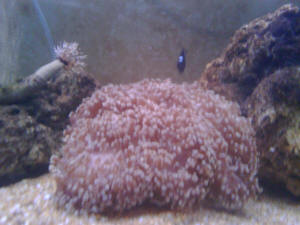 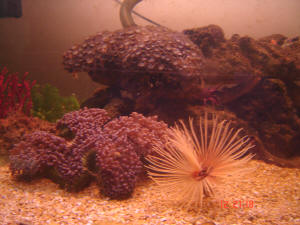 |
|
Question: Bubble Coral Skeleton, no data of use
10/3/08 Hi there! <Mindy> I've had 1 small and
1 medium sized bubble coral in my nano cube for about 4 months
now. They've been doing just fine at the bottom of the sand
bed until recently. I've noticed that the flesh covering
their skeletons have begun to recede and it seems like some algae
has started growing over those areas. <I see this in your
photo> Their flesh will no longer expand over the skeleton
where the algae has grown. I've included a picture of one of
them for your reference. I asked my LFS what could be causing
this, and he said it's possible they're being hit with
too strong of a current, causing the fleshy parts to recede and
make the skeletons visible. <Mmm, possibly, but doubtful this
is the root cause here> I've since changed the direction
of the current so it does not affect them too much. What can I do
about the algae growth on their skeletons? <Improve
conditions, feeding...> I'm afraid to try to rub it off,
<I would NOT do this> I don't want to irritate the
bubble corals. And is it possible to add trace supplements like
iodine to the tank to help the corals heal and grow their
skeletons? <Oh yes> Please advise. Thanks so much for your
help! Mindy <Please learn to/use the search tool, indices on
WWM... For today, start reading here:
http://wetwebmedia.com/carydisfaqs.htm and the linked files
above. You don't state anything re water quality, lighting,
feeding... Read re the requirements of Plerogyra... Bob
Fenner>
|
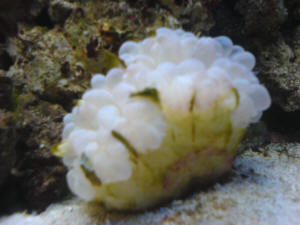 |
Torch coral damaged? Cnid. incomp., reading
-09/03/08 Hello guys, Can someone please have a look at this
picture of my Torch coral? It seems to have either holes or black dots.
<I see these... damaged areas> My Hammer coral seems to be doing
fine, <Oops... likely stinging this other Euphylliid> but lately,
this Torch has been opening a lot less than usual. this morning I
noticed this apparent damage and am quite concerned. Thanks so much for
taking the time. water: ph 8.2 Alk 1.7 calcium 400 ammonia 0 nitrites
0.05 nitrates 2 - 2.5 SG 1.025 temp 78-80 <... read:
http://wetwebmedia.com/carycompfaqs.htm and
http://wetwebmedia.com/cnidcompppt.htm and the linked files above.
Bob Fenner>
 |
dying bubble coral? Reading? -- 07/21/08 I have a 6 month old
BioCube 29, with 2 percs, hammer coral, modern brain, <?
Trachyphyllia?> frogspawn, polyps, and a big bubble coral. <...
all in a 29 cube?> For some reason it looks like the bubble coral is
detaching from it skeleton. <Likely> We feed the coral calcium
and iodine every week. <? Added how?> I target feed every other
day. I feed Cyclop-Eeze and PhytoPlex everyday. I'm just super
confused as to why he would be dying...the clowns don't host him,
he gets fed, get enough light. Any insight? <Allelopathy... Read
here: http://wetwebmedia.com/cnidcompppt.htm and the linked files
above, and re each of the species of Cnidarians you list... Likely the
Euphyllia is the "winner" here, but could be whatever
you're referring to as "polyps"... Bob Fenner>
Torch Coral, Deceptive Retailing - 6/20/08 Hello,
<Hello Jasen!> I purchased a branching torch coral from a LFS and
did not see the guy add it to the bag. <Uh-oh...Monday night
quarterbacking: Always watch> I got the coral home and the skeleton
is smashed. They had all the pieces stuck in some PVC pipe so it looked
normal. The tentacles were all expanded nicely. I placed the parts in
some rock crevices, but I have little faith it will survive.
<Provided the polyps didn't lacerate themselves beyond
recognition in the bag, they should be okay...skeleton is only dead
calcium carbonate> One piece may still have the mouth. I called the
store and they stated that once it is paid for its mine. <Policy is
policy, but I wouldn't visit them again- and consider spreading the
word about their business practice. Word of mouth makes good shops, and
breaks the bad ones> This will be my last purchase there. Any idea
would be appreciated. <If the polyps are damaged, pristine water
quality and water flow may help heal them, as well as supplementation
of iodine in their general direction.> Thanks, Jasen <No problem.
Good luck with your coral. Benjamin>
|
|

